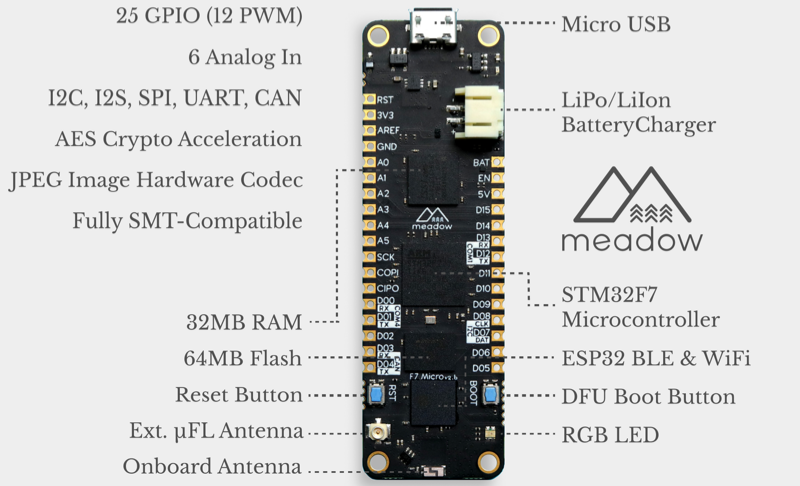Today I'm talking about Meadow Hack Kit. If you're unfamiliar with this technology or want to learn more, keep reading. Meadow is a complete Enterprise-grade IoT platform that runs .NET applications on embeddable microcontrollers. It's a plug-and-play IoT library with a huge selection of peripheral drivers and a prototype-friendly developer kit that enables you to build prototypes on real hardware. It also supports Turnkey surface-mount (SMT) hardware modules, and the cloud enables you to manage your devices at scale.
You may wonder, what's IoT? In short, the Internet of Things (or IoT) refers to a system of interrelated, interconnected objects (or things as abbreviation states) that collect and transfer data over a wireless network without human intervention. The possibilities and benefits are endless. A 'thing' might be a connected medical device, a transponder, solar panel, a connected automobile with sensors that measure tire pressure, fuel level, required maintenance, or basically, any sensors that collect data etc. As mentioned, the area of applicability can vary. For example, I had a project where we had to develop an application that measures the wind speed at the top of skyscrapers. As you may know, skyscrapers are designed to sway in high winds. Our app had to register the wind speed at the rooftop, so the tilt angle for the entire building could be calculated. The volume of data could reach gigabytes from one sensor daily. Statistical data gathered this way can be critical for decision-making. The ultimate goal of this series is to provide you with an intro to the world of IoT, show you how to get started with assembling the 'thing' or device based on Meadow Kit and how it can be used for data gathering.
I hope you guys are still awake and didn't lose interest in this discipline. Before I proceed with the Kit review, I want to say a couple of words about the company that manufactures these kits and why you might be interested in learning more in this direction. So, the Meadow F7 by Wilderness Labs is a full-stack .NET IoT platform that was successfully funded (or rather crowdfunded) on Kickstarter last year. The US company based in Oregon designs boards to be modern plug-and-play platforms to get users started quickly. For the users who want to start in IT, this is a very prospective direction that combines not just software but also hardware development. This is an exceptional opportunity for the existing developers to broaden their knowledge horizons and learn something new to elevate their skills to the next level. This is exactly where the rubber meets the road when you combine developed software with the hardware. You may have heard of Arduino or Adafruit platforms before, but those require more knowledge to get started due to a distinct technology stack. If your primary dev stack is .NET, you can get up and running quickly, as Meadow Hack Kit uses .NET and C# to develop the applications, which makes things a lot easier. Since the .NET Standard is supported, hundreds of NuGet packages and plugins are available. As the next step, you can even leverage cloud services, such as AI or Machine Learning, particularly for data, image and video processing and analytics.
I guess we're done with the objectives for this series. Next, I will explain the contents of the box (Meadow Hack Kit Pro). This is the only thing you need to get started, aside from the computer with Visual Studio installed.
Hack Kit
It's a relatively big box with a huge number of different components. The F7 board is a centrepiece of the Meadow Hack Kit Pro. It's the perfect start to learn the ropes in embedded electronics and IoT projects. The box comes with a compartmentalized plastic case that organizes a wide selection of different components. And by the way, I do like the quality of this kit a lot.
A piece of laser-cut wood is not a drink coaster, as you may guess🙂 It's the mounting base for this F7 board:

To tell you more about this board, it's built around the STM32F7 microcontroller, which is the brain of this platform and runs a Micro Real-Time OS (mRTOS) as well as full .NET Standard compatible runtime. It features the integrated antennae at the top, the socket for the external antennae, ESP32 co-processor that provides Wi-Fi and Bluetooth capability. At the sides, you'd find a reset button and a DFU boot button (DFU means Device Firmware Update). A little lower on the board is a 32Mb flash storage and then a microcontroller itself. Also, the board houses 16Mb of RAM for running large programs and the socket, so you can power it with a Lithium-Ion battery. At the bottom, there's a micro-USB connector that allows you to connect this board to your computer. To tell you more, the form-factor of this board works seamlessly with Adafruit's Feather ecosystem. It enables users to take advantage of the expansion boards, including UHF transceivers, memory loggers, and GPS modules.
Also, in the box, you'll be able to find a bunch of other components like:
-
Wire jumpers (jumper wires for breadboard prototyping)
-
Resistor Kit (judging on the marks - varying resistance)
-
Capacitor Kit (various value capacitors)
-
A bunch of pushbuttons
-
Two micro servos
-
Two rotary encoders
-
2 DC motors
-
A bunch of IC's (integrated circuit)
-
Two rainbow LEDs
-
Various colour LEDs
-
Transistors
-
Luminosity, temperature and moisture sensors
-
USB breakout
-
Two-position switches
-
Single row breakaway headers
-
Diodes
-
2-channel relay board
-
LCD character display
-
Color LCD display
-
Two half breadboards
-
Blue female header pins, screws and nuts
In the next part, I will assemble the board, pair it with my PC, and install the updated firmware to start hitting the keyboard to develop the software app that will be deployed to this device.
Stay with me to learn more!
References: